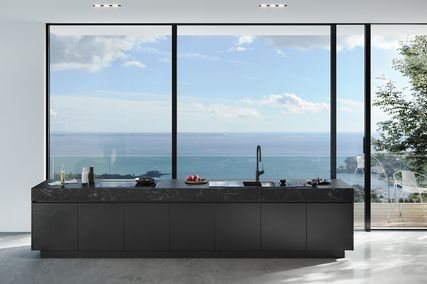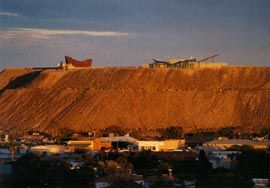
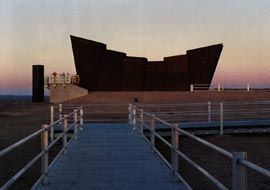

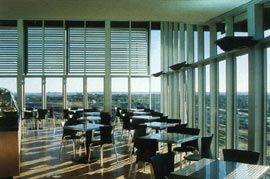
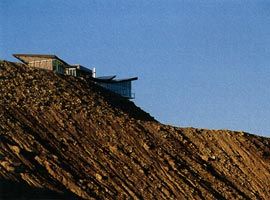
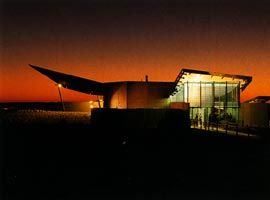
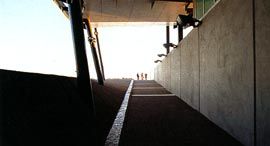
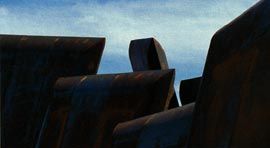
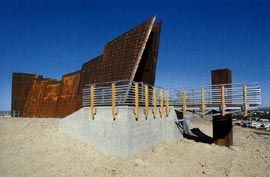

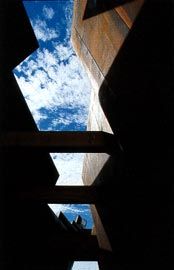
The unique site of the Line of Lode Miner’s Memorial and Visitors Centre, on the edge of the mullock heap that bisects the city of Broken Hill, could not provide a more dramatic and visible location. This drama is heightened after dark, when the floodlit buildings appear like a beacon shining across the city. Seen from a distance at dusk, the first impression is of the symbiotic relationship between the two buildings and their almost ephemeral quality against the dark and threatening bulk of the mullock, looming 30 metres above the city. Once on top of this man-made mound, shadow becomes substance. The fragmented steel roof soars above the concrete wall of the Visitors Centre, creating a twisting, diminishing entrance, drawing the visitor into the building.
The robust steel and concrete construction and strong geometric forms of the two buildings reinforce their physical relationship; however the Miner’s Memorial remains the dominant structure. The massive vertical elements of the memorial contrast with the lighter, more complex form of the Visitors Centre with its distinctive roof floating above anchoring concrete walls. The strong visual relationship between the two buildings is reinforced by the processional journey designed to lead visitors through the centre and across the mound to the memorial.
The start of this journey, through an increasingly constricted space, is intended as a metaphor for the experience of the miners. It represents the inevitability of working in the mines and the uncomfortable working conditions in a damp, claustrophobic underground environment. Water flowing beside the path heightens the experience, as do the continuous audio-visual representations of miners at work. Beyond the entrance, the building opens up to reveal a cafe and a souvenir shop, while visual cues lead the visitor to a glass viewing area showcasing the Miner’s Memorial. With this strong visual connection and growing sense of anticipation it is a minor disappointment that the visitor is then diverted through the souvenir shop, en route to the memorial.
The journey then becomes one of human frailty and exposure to the elements. It continues outside across a steel walkway perched above the toxic mullock heap, before bringing the visitor directly onto a ramp, which seems to anchor the structure back into the earth and leads into the major axis of the Miner’s Memorial. This axial progression passes through the cathedral-like space of the memorial and, finally, out onto a viewing platform perched over the edge and confronting the city, to remind the visitor of the diminishing role of mining in the community.
The design of the memorial is both simple and complex. The simplicity lies in the plan. The east-west axis – marking the rising and setting of the sun – forms a cross with the main north-south axis to the city – representing the women and children of Broken Hill. The complexity lies in the dramatic steel structure defining external form and internal space. Heavy steel panels gradually fold overhead as a contextual reference to the mining industry, evoking the danger and camaraderie experienced by the miners as well as the enclosure experienced underground. This impression of being underground is accentuated by the symbolic timber props bracing the steel panels – panels which at first constrict and then open up again to frame the sky and view across the city.
Visiting the Line of Lode complex by day and at night provides two very different experiences. At night, the view of the lights of Broken Hill to the north and south is breathtaking. The extensive glazed walls of the cafe maximise this experience. During the day, the views are still exceptional, but less distracting and the visitor can focus on the memorial and the human tragedy it represents. A lasting impression is of the freestanding glass panels within the memorial, etched with the names of those who have died mining the Line of Lode since 1883. The glass panels run the length of the memorial and contrast with the russet patina of the weathered BHP Austen steel sheet.
The history and unique identity of Broken Hill has clearly influenced the design of the complex. Architecture as experience goes beyond building as shelter; it should also fuel the imagination and fire the soul. The Visitors Centre as gateway and the Miner’s Memorial as monument also reflect the memories and spirit of Broken Hill.
The Line of Lode Miner’s Memorial is an icon for Broken Hill and the mining industry.
It is also a symbolic and spiritual representation of the human tragedy of more than 800 deaths since mining commenced in Broken Hill. For the community, the Line of Lode Miner’s Memorial and Visitors Centre provide the first opportunity for those not employed in mining to visit the site. Floral tributes beside some of the hundreds of names in the memorial are a testimony that grief and memories are ever present.
Project Description
The Miner’s Memorial and Visitors Centre at Broken Hill is the result of an ongoing collaboration between the Louis Laybourne Smith School of Architecture and Design at the University of South Australia, the Line of Lode Association, and the mining community. The project is part of a much larger site leased back to the community for development as an educational and tourism centre. With only a few years of mining ahead, Broken Hill has identified tourism as a key strategy for survival. A Federation Grant enabled the construction of the memorial and visitors centre, and funded other restoration work on the former mine leases which are set to become one of the most significant industrial heritage sites in Australia.
Since 1996, architecture students at the University of South Australia have been involved in studio projects relating to the site. One of those projects, the Miner’s Memorial, is now a reality. The memorial commemorates the 800 or more miners who lost their lives working along the Line of Lode. Designed by final year students Angus Barron, Steve Kelly and the late Dario Palumbo, with design development and documentation by Angus Barron, the project was completed under the supervision of senior lecturer and architect Chris Landorf.
In 1998, the university was also engaged to design and document a visitors centre.
Designed by Landorf and David Manfredi as a gateway to the Miner’s Memorial, the Visitors Centre also provides an introduction to the city’s economic, technological and political place in our national history. A process of community consultation and historical research, including reference to oral histories from the city, were significant drivers of the centre’s theoretical framework.
Project Credits
Line of Lode Miner’s Memorial and Visitors Centre
Architect The University of South Australia— Visitors Centre design and project architects Chris Landorf and David Manfredi; Miner’s Memorial design Angus Barron, Steve Kelly and Dario Palumbo; Miner’s Memorial documentation Angus Barron and Chris Landorf; Miner’s Memorial project architects Chris Landorf and David Manfredi.
Engineers TMK Consulting Engineers (Visitors Centre), Connell Mott MacDonald (Miner’s Memorial).
Builder De Franceschi & Sons.
Cost Management Lees Cadman.
Client The Line of Lode Association.
Images Sam Noonan
Source
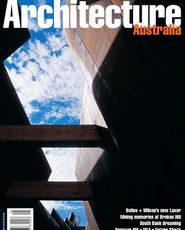
Archive
Published online: 1 Sep 2001
Words:
Carolyn Wigg
Issue
Architecture Australia, September 2001





